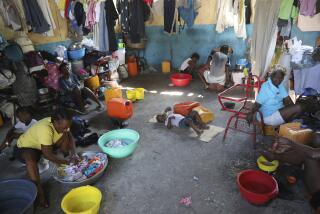Uncovering jobs a major challenge since Haiti earthquake
- Share via
Reporting from Port-au-Prince, Haiti — Pedro Milien used to bend iron into grillwork for doors and windows in Haiti’s capital. The work was sporadic and low-paying, but it felt like a blessing in a land where real jobs can seem like a mirage.
Milien’s rippling arms are now idle. Haiti’s earthquake not only toppled his home but dried up his work. His meager savings are spent.
“We used to have a possibility of finding work from time to time,” Milien said in the hastily fashioned shack he shares with six family members. “A lot of the people who used to give me work, give me hope — a lot of them are dead now.”
More than six months since the Jan. 12 quake flattened much of Port-au-Prince, one of the biggest challenges facing the recovery effort is finding work for untold thousands of Haitians who lost their toehold in the economy, or never had one.
Hard hit were craftsmen, street vendors and day laborers, plus small-time business owners — shopkeepers, garage owners — with modest workforces. The quake deepened a jobs crisis in Haiti, where unemployment was already estimated at 70% or higher.
Earthquake victims and officials say the battered country may never get back on its feet if employment doesn’t get a boost. Haiti’s economy is expected to shrink by 8% this year.
“If you don’t have jobs, you have a situation where people are looking for and receiving free services that disrupt local markets,” said Carleene H. Dei, USAID mission director in Haiti. “That’s not tenable.”
Quick fixes are in short supply.
Planners envision new industrial parks that would employ thousands of Haitians, for example, and they see potential in an expanded agricultural sector. But it could take years to erect factories and reestablish businesses felled by the magnitude 7.0 quake. Reconstruction projects are likely to offer plenty of work, but the commission that will oversee them is barely underway.
And the grand talk of remaking their nation rings hollow to many Haitians who have listened to lofty promises before but never been able to climb out of misery.
The most immediate remedy has been to hire Haitians on a temporary basis to clear rubble and trash and clean drainage channels. USAID pays $5 a day to about 20,000 people. Some aid groups compensate camp dwellers with food.
Pressure to find work has been more acute since food giveaways ended in the 1,300 makeshift encampments a few months ago. Haitian President Rene Preval said the handouts undermined Haitian producers.
The jobless manage as they always did, pooling money and food. But now many more are without work, including those with catch-as-catch-can jobs that didn’t count in any official tallies. A survey by the Oxfam relief group found the number of people without work quadrupled in areas of Port-au-Prince and its hard-hit outskirts.
Oxfam offers grants and training for mom-and-pop businesses — masons, tailors, beauticians — to get them back on their feet. USAID-sponsored loans averaging $150 can help small-business owners, the heart of Haiti’s modest middle class, to make repairs or maintain operations and hire back employees, officials said.
The Clinton Bush Haiti Fund recently announced $1 million in grants to spur hiring by small and midsized enterprises, such as artisan shops and garment makers.
The Inter-American Development Bank is helping finance construction of an industrial park in northern Haiti and expansion of the government-run complex in Port-au-Prince that is the center of the garment industry.
Haitian apparel factories employ about 25,000 people. Officials say the number of jobs can grow significantly with more plants and investment in water, electricity and other basics.
Congress has passed legislation to increase Haitian exports and boost garment and textile jobs by expanding duty-free access to the U.S. market. Experts say the number of garment jobs could someday reach 450,000, though the work is low-paying.
“The potential is there to increase the number of jobs,” said Eduardo Almeida, representative in Haiti for the Inter-American Development Bank. But, “it’s going to take time.”
That’s the last thing unemployed Haitians want to hear.
Riliane Fleurant, 23, peddled beauty supplies downtown before the earthquake destroyed the building where she stored her goods.
“Everything was there,” said Fleurant, scrubbing clothes in front of the dirt-floor shack she shares with her boyfriend and son, who was born three days before the quake.
The couple’s income dropped from $12 a day to the $2.50 her boyfriend earns selling cosmetics. Fleurant hasn’t looked for work and said she has no idea what to do.
“I know how to sew,” she offered. “I’m a very good cook.”
ken.ellingwood@latimes.com
More to Read
Sign up for Essential California
The most important California stories and recommendations in your inbox every morning.
You may occasionally receive promotional content from the Los Angeles Times.










